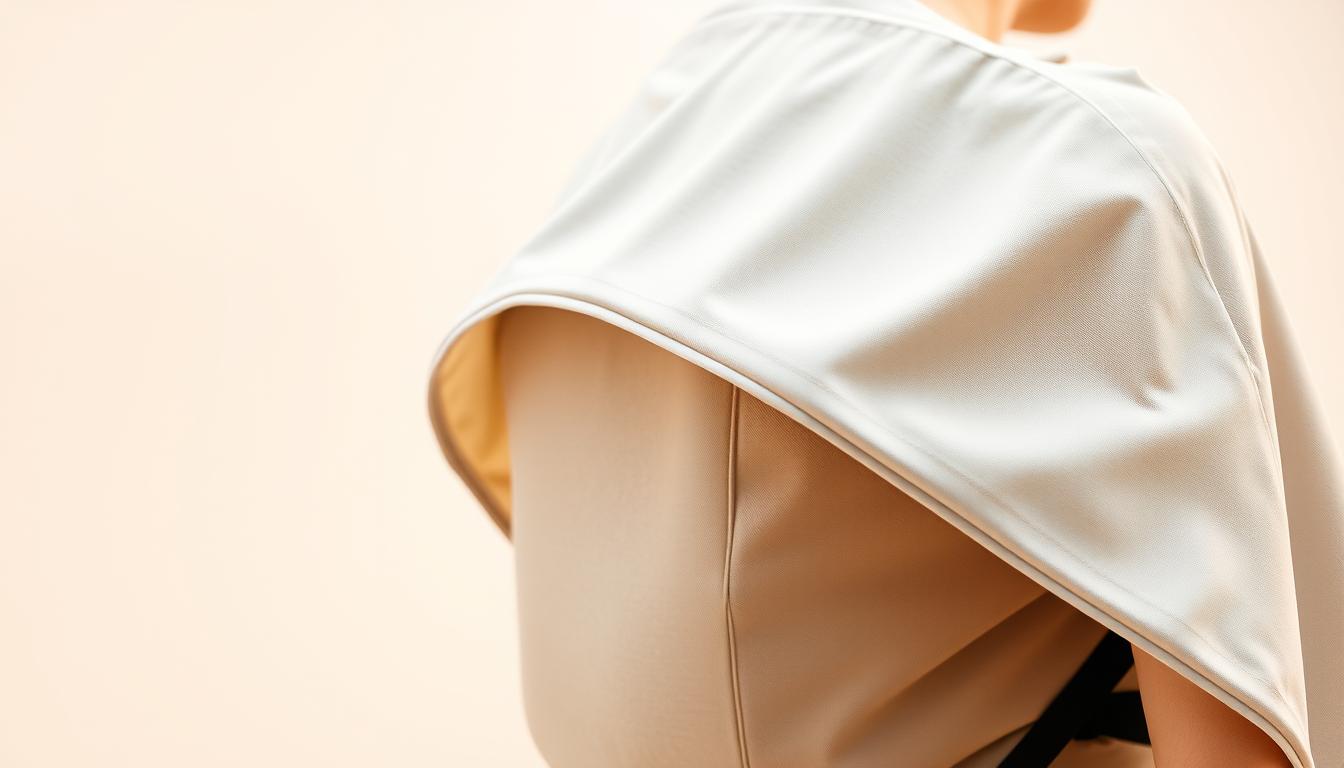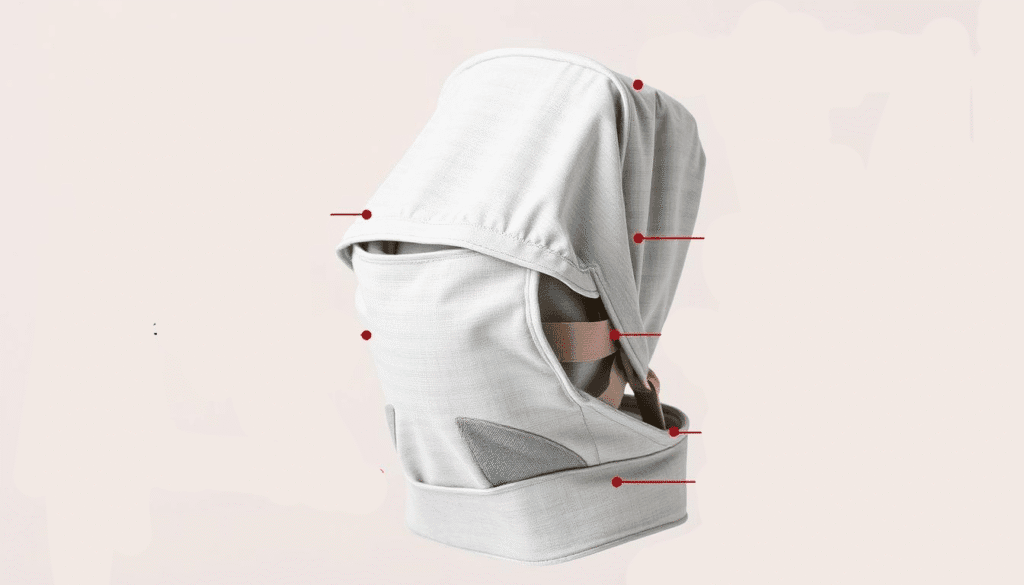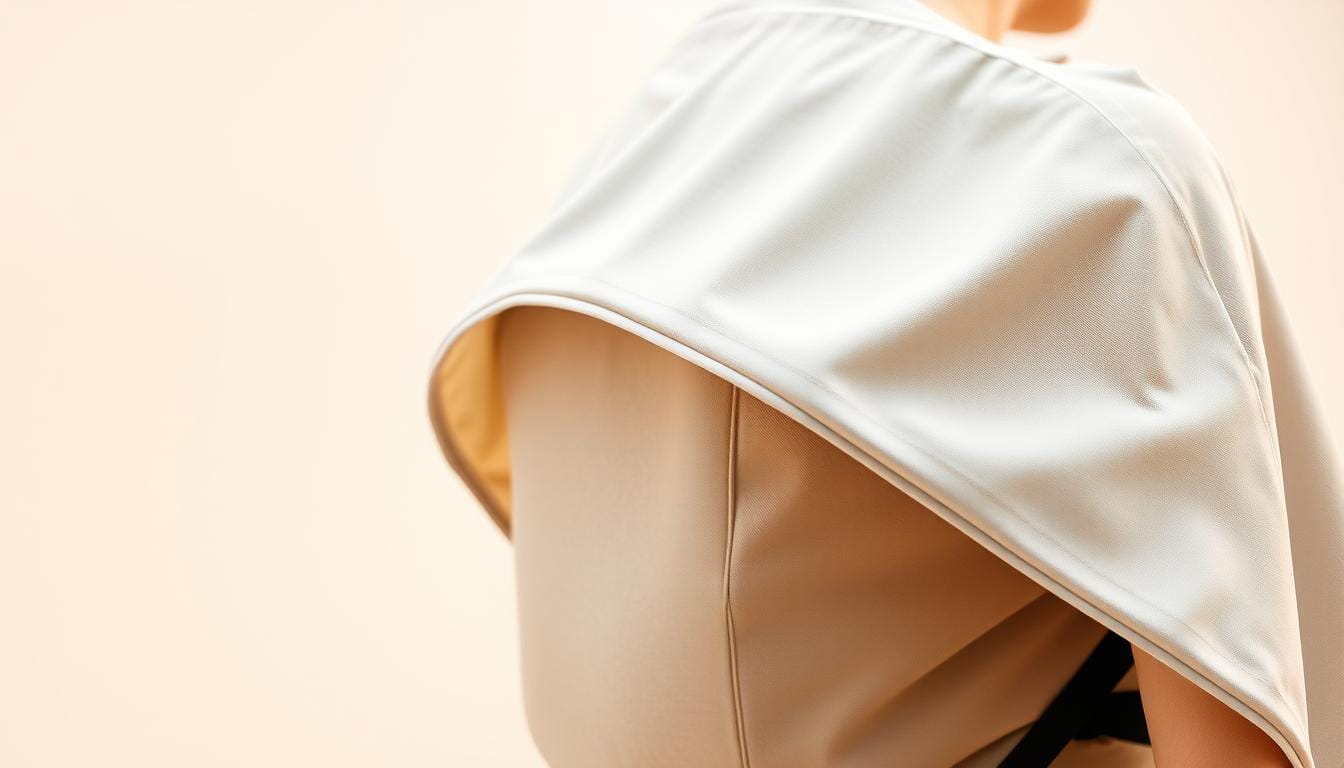As a parent, you want your baby to be comfortable and safe. Harsh weather can make it hard to use your ergonomic baby carrier in cold months. A baby carrier cover is key. It keeps your child warm and safe from the weather.
Our weather cover for your ergonomic baby carrier has a soft fleece inside and a windstopper outer. It’s both windproof and water-resistant. So, you can use your baby carrier all year, no matter the weather.
Key Takeaways
- A baby carrier cover provides protection from harsh weather conditions.
- It keeps your baby cozy and secure while babywearing.
- Our cover features a soft fleece lining and windstopper outer fabric.
- It’s windproof and water-resistant, making it perfect for year-round use.
- Using a baby carrier cover ensures your baby’s comfort and safety.
Understanding Baby Carrier Covers
A baby carrier cover adds comfort and protection to babywearing. It’s a fabric layer that goes over the baby carrier. This keeps the baby cozy in different weather.
Definition and Basic Functions
A baby carrier cover is a fabric layer for the baby carrier. It protects the baby from the outside. It can be made from breathable cotton, waterproof fabrics, or warm fleece. Its main job is to keep the baby dry, warm, or cool.
Key Components of a Quality Baby Carrier Cover
When searching for a best baby carrier cover, look for certain features. A good cover should be breathable and waterproof. It should also be easy to put on and take off.
| Feature | Description | Benefit |
|---|---|---|
| Breathable Material | Made from materials that allow air to pass through | Keeps the baby cool and comfortable |
| Waterproof Layer | Includes a layer that prevents water from penetrating | Protects the baby from rain or snow |
| Easy Attachment | Designed for simple and secure attachment to the carrier | Makes it convenient to put on and take off |
Understanding what a waterproof baby carrier cover is and what it does helps parents choose the right one. This ensures the baby stays comfortable and safe.
Benefits of Using a Baby Carrier Cover
Baby carrier covers offer many benefits, like weather protection and added comfort. They are great for rainy days or sunny afternoons. They make outings with your baby more enjoyable.
Weather Protection for Your Little One
A winter baby carrier cover or a baby carrier rain cover is essential in bad weather. It keeps your baby warm and dry. This way, you can go out without worrying about the weather.
Privacy During Nursing and Napping
Using a baby carrier cover also gives you privacy when nursing or napping. It creates a private space for your baby. This makes feeding or soothing them in public easier.
Additional Comfort for Your Baby
An ergonomic baby carrier cover adds to your baby’s comfort. It helps keep their body temperature right. This makes them feel cozy and comfortable while you wear them.
| Benefit | Description |
|---|---|
| Weather Protection | Keeps baby warm in winter and dry in rain |
| Privacy | Provides seclusion during nursing and napping |
| Comfort | Enhances baby’s comfort by regulating body temperature |
Types of Baby Carrier Covers Available
Baby carrier covers come in many types. They are made for different needs and weather. You can find a cover to keep your baby safe from the weather or for more privacy.
Universal vs. Carrier-Specific Covers
When picking a baby carrier cover, think about if it’s universal or carrier-specific. Universal covers fit many carriers. They’re great for parents who use different carriers or have future babies. Carrier-specific covers fit one brand or model well. They might work better.
Seasonal Covers: Winter, Rain, and All-Season Options
Seasonal covers protect against certain weather. Winter covers keep your baby warm. Rain covers are waterproof for rain and wind. All-season covers are good for any weather. They’re breathable in warm weather and some protection in cooler weather.
| Season | Cover Type | Key Features |
|---|---|---|
| Winter | Insulated Cover | Thermal insulation, wind protection |
| Rain | Waterproof Cover | Water resistance, wind protection |
| All-Season | Breathable Cover | Breathability, some insulation |
Specialized Designs: Nursing Covers, Sleep Hoods, and More
There are specialized designs for specific needs. Nursing covers offer privacy for feeding. Sleep hoods protect your baby’s head and face while they sleep. These covers make your baby carrier more useful.
Knowing about the different baby carrier covers helps you choose the right one. It should fit your lifestyle and your baby’s needs.
How to Choose the Right Baby Carrier Cover
Finding the perfect baby carrier cover can seem hard. But, by looking at a few important things, you can make a good choice. Think about your climate, lifestyle, and the baby carrier you use.
Assessing Your Climate and Lifestyle Needs
Your climate and lifestyle are key in picking a baby carrier cover. For cold places, you need something warm. In warm areas, a light, airy cover is better. Also, think about your daily activities. If you’re outside a lot, a waterproof cover is a must.

Material Considerations: Breathability, Waterproofing, and Insulation
The material of your cover is very important for your baby’s comfort and safety. Look for covers that breathe well, are waterproof, and keep warm in cold weather. A good cover balances these needs. As “The right material can make all the difference in your baby’s comfort and your peace of mind.”
Compatibility with Your Specific Carrier
Not every baby carrier cover fits every carrier. Make sure the cover you pick fits your carrier. Check the maker’s advice and read what others say to be sure it fits.
By thinking about these points, you can find a baby carrier cover that fits your needs. The right cover can add protection, comfort, and ease to your babywearing journey.
Step-by-Step Guide to Installing Your Baby Carrier Cover
To get the most out of your baby carrier cover, it’s key to install it right. A well-installed cover keeps your baby comfy and safe from the weather.
Preparing Your Carrier
Before attaching the cover, clean your baby carrier. Make sure it’s free from dirt. Check the instructions for any special setup needs.
Attaching the Cover Properly
To attach the best baby carrier cover, follow the instructions. Most covers have straps or Velcro to secure them. Make sure the cover fits just right, not too tight or too loose.
Testing for Security and Comfort
After attaching the cover, test it for safety and comfort.
Ensuring Proper Fit
Make sure the cover fits snugly but doesn’t block your baby’s face or limit their movement. A good fit is essential for safety and comfort.
Checking Baby’s Comfort
Watch how your baby reacts to the cover. If they seem uncomfortable, adjust it. You want a cozy spot without sacrificing safety or visibility.
For a winter baby carrier cover, think about insulation. It should keep your baby warm without being too heavy. Always check the manufacturer’s guidelines for the best use.
By following these steps, you’ll ensure a safe and comfy fit for your baby. This will make your babywearing experience better.
Winter Baby Carrier Cover Essentials
As winter comes, a winter baby carrier cover is a must-have for parents who love babywearing. It should be warm, breathable, and have a waterproof layer to keep out the cold.
Features to Look for in Cold Weather Covers
Look for a cover with a warm fleece lining and breathable materials. A waterproof outer layer is also important. An ergonomic design ensures a comfortable fit for you and your baby. Adjustable Velcro or snap fasteners are great for a secure fit.
Layering Strategies for Maximum Warmth
Layering is key to keeping your baby warm. Start with a thin, breathable base layer. Then add a warm fleece or wool layer. Finish with a waterproofwinter baby carrier cover to keep out wind and rain. This keeps your baby’s body heat in.
Monitoring Your Baby’s Temperature
It’s important to watch your baby’s temperature while babywearing in winter. Look for signs of overheating like sweating or flushed cheeks. Adjust the layers as needed. You can also use a
By following these tips and picking the rightwinter baby carrier cover, you can enjoy babywearing with your little one, even on the coldest days.
Waterproof Baby Carrier Covers for Rainy Days
A waterproof baby carrier cover keeps your little one dry and comfy on rainy days. Rain shouldn’t stop you from enjoying time with your baby. The right cover lets you stay close while keeping them dry.
Best Materials for Water Resistance
Choosing the right material is key for a waterproof baby carrier cover. Look for ones made from waterproof fabrics like nylon or polyester. Some also have breathable membranes to keep your baby dry and comfy.
Quick-Drying Options
A quick-drying cover is a must for rainy days. It prevents your baby from getting cold or clammy. Covers with quick-drying technology are perfect for wet weather.
Storage Solutions for Wet Covers
Wet covers are a fact of life. A storage solution like a waterproof bag is very useful. It keeps your belongings dry while you store the wet cover.
Safety Considerations When Using Baby Carrier Covers
Using a baby carrier cover safely is key for a good time with your little one. These covers protect from the weather and make your baby more comfortable. But, it’s important to use them the right way.
Ensuring Proper Airflow
Good airflow is essential to keep your baby cool and comfy. Look for covers that breathe well and let air in. Some have mesh panels for better air flow.
Visibility and Monitoring Your Baby
It’s important to keep an eye on your baby all the time with a carrier cover. Pick a cover that lets you see your baby’s face easily. Some have special windows or parts that you can adjust.
Avoiding Overheating Risks
Staying cool is a big deal with baby carrier covers, more so in hot weather. Stay away from thick or non-breathable covers in warm weather. Go for light, breathable ones and watch your baby’s temperature.

By thinking about these safety tips and picking the right cover, you can have a safe and fun time with your baby.
Maintaining and Cleaning Your Baby Carrier Cover
Proper care for your baby carrier cover can make it last longer. Regular washing and proper storage are key to keeping it in top shape.
Washing Instructions by Material Type
Different materials need different washing methods. Cotton covers can usually be machine washed. But covers made from delicate materials might need to be hand washed.
- Cotton and linen covers: Machine wash cold, gentle cycle.
- Synthetic materials: Check manufacturer’s instructions, often machine wash cold.
- Delicate or wool covers: Hand wash in cold water, reshape while wet.
Storage Tips to Extend Lifespan
Storing your baby carrier cover right can help it stay in good condition. Keep it in a cool, dry place, away from sunlight.
When to Replace Your Cover
It’s important to know when to replace your baby carrier cover. Do it if it has fraying, holes, or stains that won’t go away.
| Material | Washing Method | Average Lifespan |
|---|---|---|
| Cotton | Machine wash cold | 6-12 months |
| Synthetic | Check manufacturer’s instructions | 6-12 months |
| Wool or Delicate | Hand wash cold | 3-6 months |
Conclusion: Enhancing Your Babywearing Experience
A baby carrier cover can make your babywearing experience better. It adds comfort, protection, and convenience. It keeps your baby cozy in different weather.
An ergonomic baby carrier cover fits well over your baby carrier. It adds extra comfort and protection. It’s great for harsh weather or to keep things private.
Choosing the right baby carrier cover makes babywearing more fun and easy. Think about your climate, lifestyle, and your baby’s needs. The right cover keeps your baby safe and comfy.
FAQ
What is a baby carrier cover, and why do I need one?
A baby carrier cover is a special accessory for babywearing. It protects your baby from wind, rain, and cold. This way, you can use your baby carrier all year round.
What are the benefits of using a baby carrier cover?
Using a baby carrier cover has many benefits. It keeps your baby safe from the weather. It also helps with privacy and adds comfort.
What types of baby carrier covers are available?
There are many types of baby carrier covers. You can find universal covers, ones made for specific carriers, and seasonal ones. There are also nursing covers and sleep hoods.
How do I choose the right baby carrier cover for my needs?
To pick the right cover, think about your climate and lifestyle. Choose one that’s breathable, waterproof, and fits your carrier. Think about what you need and what you like.
How do I install a baby carrier cover?
Installing a cover involves preparing your carrier and attaching the cover. Make sure it’s secure and comfortable for your baby. Follow a guide for a proper fit.
What features should I look for in a winter baby carrier cover?
For a winter cover, look for a warm fleece lining. Also, choose breathable materials and a waterproof outer layer. These features will keep your baby warm and cozy.
Are waterproof baby carrier covers effective?
Yes, waterproof covers keep your baby dry in the rain. Look for covers made from water-resistant materials. Also, consider quick-drying options and how to store a wet cover.
How do I ensure my baby’s safety while using a baby carrier cover?
To keep your baby safe, ensure good airflow and visibility. Avoid overheating risks. Watch your baby’s temperature and know the risks of using a cover.
How do I maintain and clean my baby carrier cover?
Regular care and cleaning are key to keeping your cover in good shape. Follow the washing instructions for your material. Store it properly and replace it when needed.
Can I use a baby carrier cover with any baby carrier?
Many covers are universal, but some are specific to certain carriers. Check if your cover fits your carrier before buying.
What are the best materials for a baby carrier cover?
The best materials depend on what you need. Look for breathable materials like cotton or mesh. Also, consider waterproof materials like nylon or polyester. For cold weather, insulating materials like fleece are good.
